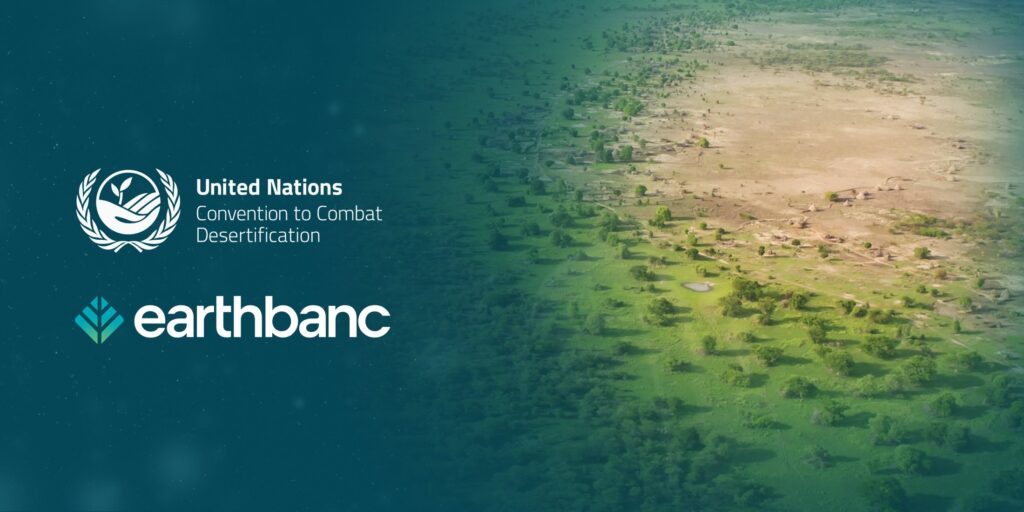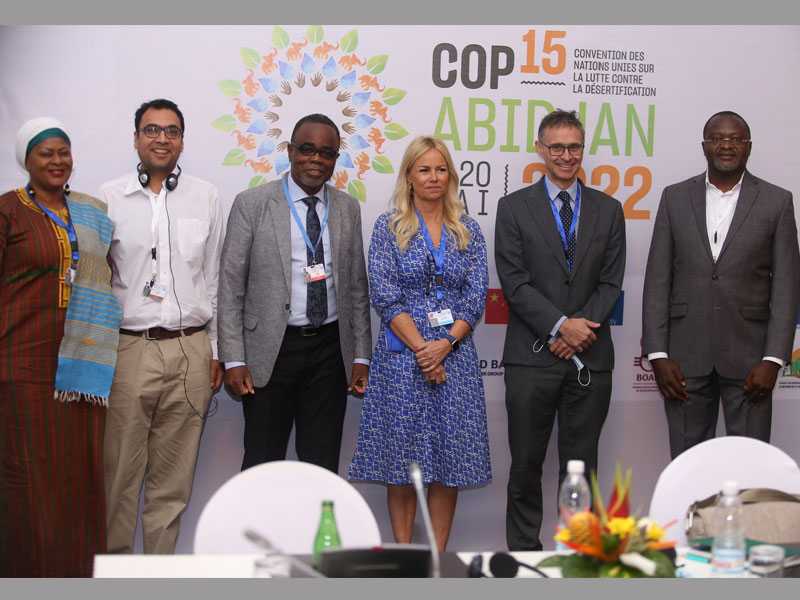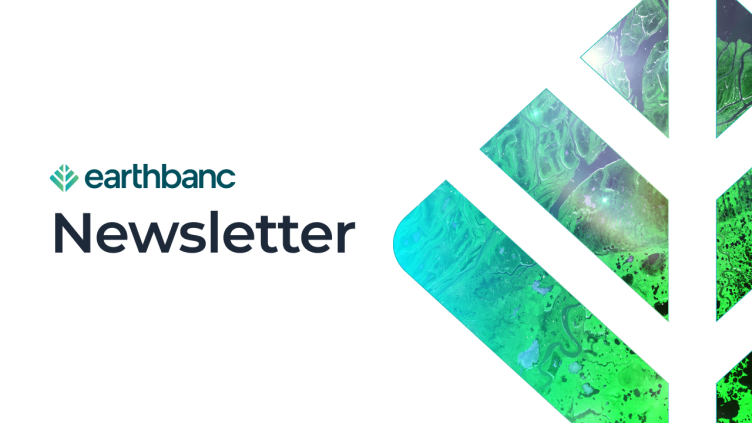
Earthbanc has signed a partnership with the United Nations Convention to Combat Desertification (UNCCD) to explore options for launching a global fintech and carbon credit platform that finances land restoration and carbon removal. It would enable investors to support projects that directly advance the goals of the UNCCD Land Degradation Neutrality (LDN) targets.
Today, 129 countries have expressed their willingness to set targets and achieve Land Degradation Neutrality (LDN). This means billions of hectares of land across the world will be restored to health and vast amounts of carbon, up to 2.9 billion tonnes annually according to the IPCC, will be sequestered into soils, trees and ecosystems.
Mr. Rishabh Khanna, Chief Impact Officer at Earthbanc and a steering committee member of the Initiative of Land, Lives and Peace (LLP), presented a new initiative launched together with the UNCCD at COP15 summit – the new digital Sustainable Land Bonds product, which offer a cost-effective method for financing sustainable landscape and ecosystem restoration outcomes by acting as a universal carbon removal pre-purchase instrument, whereby carbon buyers can secure their supply and discounted price at an earlier stage of development.
“Finance for land and ecosystem restoration makes up less than 1% of all climate finance due to a lack of universal capital market products for these activities, yet ecosystem restoration is one of the largest carbon removal opportunities”, according to the IPCC report issued in April, 2022.
The bottleneck has been monitoring, reporting and verification (MRV) of sustainable land management (SLM) – it has been labour intensive, sometimes inaccurate and uses fragmented measurement and accounting methodologies. The UNCCD Land Degradation Neutrality (LDN) biophysical indicators provide a global mechanism and protocol-level set of metrics for digital Sustainable Land Bonds that can be cost-effectively measured and monitored with new satellite and remote sensing methodologies that leverage machine learning.
“These UNCCD LDN metrics have been embedded into a new Digital Sustainable Land Bonds product issued by Earthbanc that follows new UNCCD aligned methodologies, and accounts for other co-benefits. Our mission is to enable businesses to achieve net zero goals through ecosystem restoration and we work with forward thinking corporations that want to take action to secure a supply of carbon removal and reduction credits, with better quality assurance. Merging digital MRV with finance for carbon mitigation and adaptation, to accelerate land restoration and carbon removal – is a huge breakthrough and we will continue to scale these solutions”, said Mr. Khanna.

Credit: African Development Bank. Pictured is Rishabh Khanna, Chief Impact Officer at Earthbanc,
UNCCD and African Development Bank COP15 delegates
Measuring Land Degradation Neutrality and Carbon Removal
This megatrend to prevent land degradation and restore landscapes has over USD 14 billion pledged for the Great Green Wall of Africa alone. The pledged funding will rely on new ‘last mile finance and payments’ fintech solutions to roll out the sustainable land management (SLM) activities. To ensure the performance of the projects is accurately measured, further support is needed from investors, governments, and carbon buyers. The recording of ecological state data and issuance of credits on a carbon registry, will occur on Regen Registry – the web3 eco-credit registry for high quality nature based solutions carbon credits that is inclusive of existing methodologies such as VERRA, and also includes new methodologies that innovate with machine learning and digital MRV.
New digital carbon monitoring, reporting and verification (MRV) tools, as well as new financing mechanisms are required to effectively address the enormity of this monitoring task. Once complete, the Great Green Wall will be the largest living structure on the planet, three times the size of the Great Barrier Reef!
Earthbanc secured venture backing from the European Space Agency to develop new AI-enabled MRV technologies that bring carbon auditing and issuance costs down 100-fold and enable carbon credit issuance to happen 5-fold faster than conventional voluntary carbon market projects. The huge cost efficiencies and remote-sensing capabilities of Earthbanc’s MRV technologies make it possible to measure and verify land degradation neutrality and carbon removal for vast amounts of land and within different landscapes.
Incentivising land restoration and carbon removal at the source
This enables Earthbanc to pay farmers up front for three years for their carbon removal from landscape restoration. This is a game changer because it incentivises land restoration to the people in the best position to do it. Earthbanc has proven this model in India, where they issued a Sustainable Land Bond to investors with a 6% APY, and from these funds paid communities to plant erosion control trees for three years in advance.

But the innovation doesn’t stop there!
The ongoing carbon revenue from the carbon credits and associated additionality of more soil and tree carbon sequestration will be paid to the planters and protectors for the next 30 years as a stream of carbon income that can add up to 91% on top of their annual income. This is life-changing and shows the connection between restoring land and creating resilient livelihoods – enabling these communities to thrive and adapt to changing climate and weather conditions.
Making investing in our planet easy and rewarding
Earthbanc is soon launching its investment platform to the public where people can align their wealth with planetary health and earn a yield whilst paying communities to regenerate landscapes. This is the Triple Top Line approach in action, creating an omni-win solution that benefits people, planet and profit simultaneously, without the trade offs we have become too used to.
Earthbanc is planning to issue new Sustainable Land Bonds that can meet the key reporting criteria developed in the framework of UNCCD and the Sustainable Development Goals for land degradation neutrality. The sustainability performance data will be available on Earthbanc’s and partners’ blockchain technology. This provides complete on-chain auditability for the land restoration data and associated finance and carbon credits – providing important quality assurance and transparency to investors and carbon buyers – whilst also helping communities improve their land tenure arrangements.
Re-imagining money
Participants in land restoration projects will be able to spend their land restoration and carbon payments via the Earthbanc app, which changes the way we think about doing good for the environment and climate, and how money incentives can align our values with our wallets. Earthbanc’s vision is to create ‘ecologically sound money’ – where every payment has an equal or greater regenerative function in the real world, making our only home planet – Earth – a beautiful place to live and thrive for all future generations. Now wouldn’t that be something to be excited about?!
Header Image Source: Great Green Wall of Africa
Blog Image: Earthbanc-financed sustainable land management activities in the Sundarbans
Click to share this page on social channels



